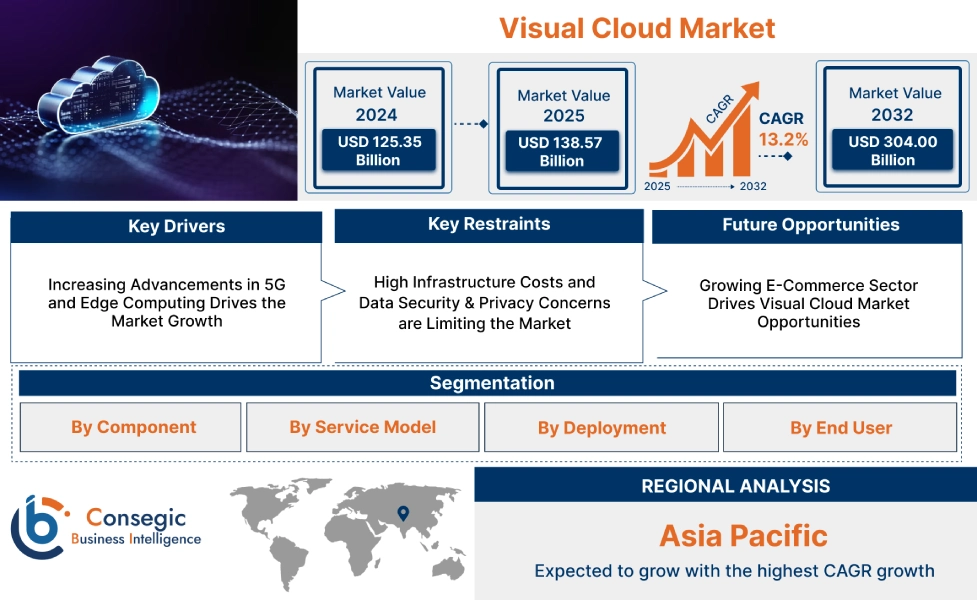Visual Cloud Market Size:
Visual Cloud Market is estimated to reach over USD 304.00 Billion by 2032 from a value of USD 125.35 Billion in 2024 and is projected to grow by USD 138.57 Billion in 2025, growing at a CAGR of 13.2% from 2025 to 2032.
Visual Cloud Market Scope & Overview:
Visual cloud refers to a specialized segment of cloud computing that focuses on the processing, delivery, and analysis of visual data, such as images, videos, and immersive content. It provides the high-performance infrastructure and services necessary to handle data-intensive visual workloads like real-time video streaming, AI-powered video analytics, augmented reality, and virtual reality applications. Further, benefits including enhanced performance and scalability, reduced latency and greater cost efficiency are driving the market. Furthermore, key trends including integration of AI and machine learning, adoption of edge computing, rising 5G market, and growing need for immersive experiences like AR, VR, and cloud gaming are driving the market.
How is AI Impacting the Visual Cloud Market?
AI is reshaping the visual cloud sector by enabling advanced analytics, content creation, and personalized experiences. AI and machine learning algorithms are used to analyze vast amounts of visual data, from detecting objects in security footage to providing real-time audience insights for streaming platforms. Furthermore, generative AI is a key driver, allowing for the automated creation and editing of visual content, such as generating 3D models and virtual environments. This integration enables more efficient workflows, delivers hyper-personalized content to consumers, and unlocks new commercial prospects across industries like media, healthcare, and retail.
Visual Cloud Market Dynamics - (DRO) :
Key Drivers:
Increasing Advancements in 5G and Edge Computing Drives the Market Growth
The synergy between 5G and edge computing is a primary driver for the cloud market. 5G networks provide the ultra-fast speeds and low latency necessary for real-time visual applications, addressing a critical bottleneck that traditional networks couldn't overcome. Similarly, edge computing processes data closer to the source, reducing the distance visual information must travel. This powerful combination allows for seamless, high-quality experiences in demanding applications like cloud gaming, AR/VR, and live video analytics. By enabling faster processing and delivery of visual content, 5G and edge computing make these technologies more practical and widely accessible across various industries.
- For instance, according to Ericsson, By the end of 2024, 85% of Europe's population had access to 5G coverage. The growing coverage is expected to boost the cloud market.
Thus, reduced latency and enhanced performance driven by 5G and edge computing drives the visual cloud market size.
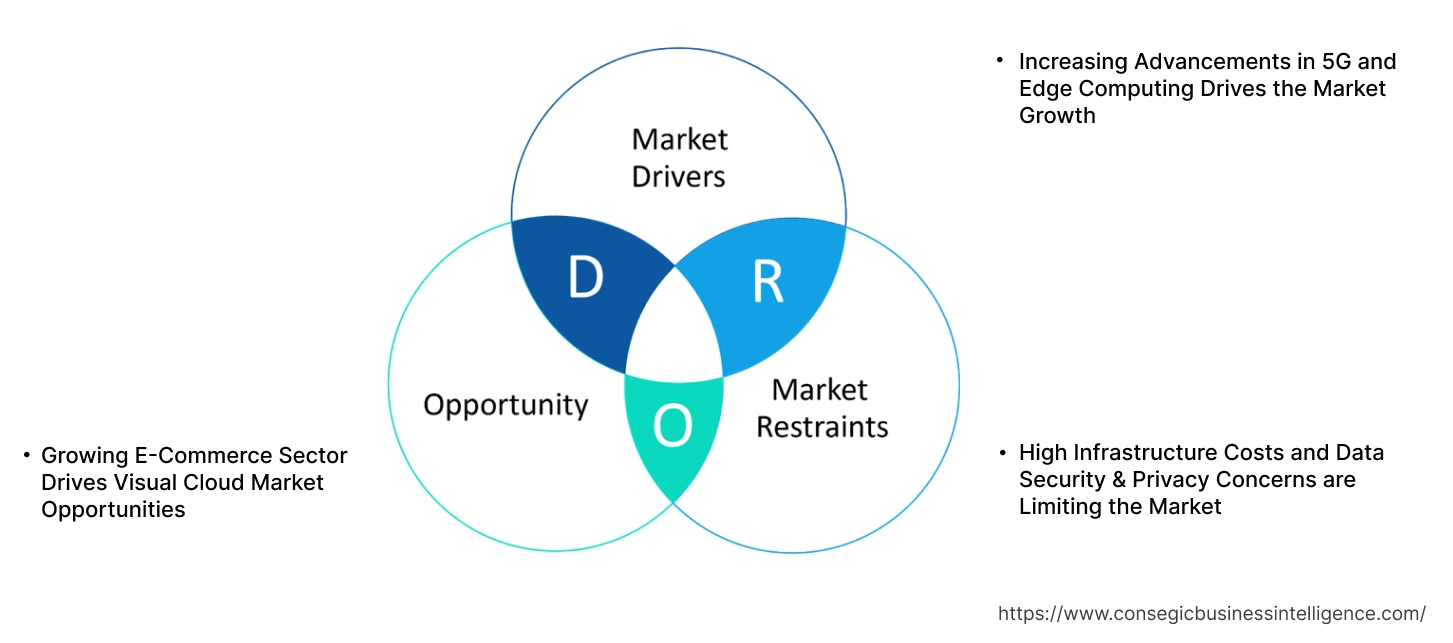
Key Restraints :
High Infrastructure Costs and Data Security & Privacy Concerns are Limiting the Market
High infrastructure costs are a significant constraint on the cloud market, especially for small and medium-sized enterprises (SMEs). The need for substantial upfront investment in specialized hardware, such as high-performance GPUs and robust network infrastructure to handle data-intensive visual workloads, can be prohibitive. This financial barrier limits the widespread adoption of the technology. Further, data security and privacy concerns present a major hurdle. As the cloud handles large volumes of sensitive information, from real-time video surveillance to personal data in AR/VR applications, there's a heightened risk of cyber threats and data breaches. Thus, adherence to complex and varied global data protection regulations increases operational costs and complicates deployment.
Future Opportunities :
Growing E-Commerce Sector Drives Visual Cloud Market Opportunities
The rapidly expanding e-commerce sector is a offers significant opportunity for the cloud market. As online retailers increasingly compete to provide engaging customer experiences, they are adopting cloud solutions to power features that were once exclusive to physical stores. This includes virtual try-on and augmented reality (AR) shopping, which allows customers to visualize products in their own space, from clothing to furniture. Further, visual cloud enables AI-powered visual search, where customers can upload an image to find similar products, and high-quality 3D product configurators. These innovations reduce product returns and boost customer confidence, making the online shopping experience more interactive and personalized than ever before.
- For instance, according to International Trade Administration, Global B2C e-commerce revenue is expected to reach USD 5.5 trillion by 2027, driven by a consistent compound annual growth rate of 14.4%.
Thus, increasing use of the technology to enhance the online shopping experience which in turn drives visual cloud market opportunities.
Visual Cloud Market Segmental Analysis :
By Component:
Based on the component, the market is segmented into solutions and services.
Trends in the Component:
- Increasing focus on solutions that can efficiently handle ultra-high-definition content, such as 4K and 8K which in turn drives the visual cloud market trends.
- Increasing use of AR/VR solutions which enable realistic and immersive experiences in the cloud for applications in training, marketing, and entertainment expected to drive visual cloud market size.
Solutions accounted for the largest revenue share in the year 2024.
- Increasing use of AI for automated video analysis, content moderation, and personalized recommendations is driving the visual cloud market share.
- Further, there is an increasing focus on edge computing which processes visual data closer to its source, in turn reducing the latency required for real-time applications such as cloud gaming, AR/VR, and live video analytics.
- Furthermore, the growth of cloud gaming is a primary factor driving the visual cloud market trends.
- Thus, AI and machine learning integration, edge computing, and cloud gaming are driving the market.
Servies is anticipated to register the fastest CAGR during the forecast period.
- Businesses are increasingly outsourcing the management of their cloud infrastructure to managed service providers, enabling them to focus on core activities while ensuring optimal performance, security, and scalability.
- Further, there is a strong emphasis toward services that offer enhanced security, data encryption, and compliance which in turn drives the market.
- Furthermore, service providers are increasingly offering solutions that support hybrid and multi-cloud environments which in turn drive the market.
- Therefore, based on analysis, managed services, focus on security and compliance, and hybrid and multi-cloud support are anticipated to boost the market during the forecast period.
By Service Model:
Based on the service model, the market is segmented into Infrastructure-as-a-Service (IaaS), Platform-as-a-Service (PaaS), and Software-as-a-Service (SaaS).
Trends in the Service Model:
- PaaS platforms are increasingly leveraging containerization technologies like Docker and Kubernetes which in turn drives the visual cloud market demand.
- Organizations are adopting IaaS from multiple providers in a multi-cloud or hybrid-cloud approach to avoid vendors lock-in which in turn drives the visual cloud market share.
Infrastructure-as-a-Service (IaaS) accounted for the largest revenue share in the year 2024.
- IaaS providers are integrating AI and automation to manage resources, optimize performance, and reduce manual work, driving the overall market.
- Further, growing availability of high-performance GPUs in IaaS environments is driving the visual cloud industry.
- Furthermore, IaaS is expanding to the network edge to process visual data closer to users in turn driving the market.
- Thus, as per visual cloud market analysis, aforementioned factors are driving the market.
Software-as-a-Service (SaaS) is anticipated to register the fastest CAGR during the forecast period.
- SaaS applications are becoming more intelligent through AI integration, enabling features like personalized user experiences, predictive analytics, and automated workflows for visual content.
- Further, with the rise of mobile content consumption, SaaS providers are prioritizing mobile-first development to ensure their visual applications which in turn propels the visual cloud market expansion.
- Furthermore, SaaS providers are offering industry-specific solutions that are tailored to the unique needs of sectors like healthcare, education, and retail which in turn drive the market.
- Therefore, vertical SaaS solutions, mobile-first development, and AI integration are anticipated to boost the market during the forecast period.
By Deployment:
Based on the deployment, the market is segmented into public cloud, private cloud, and hybrid cloud.
Trends in the Deployment:
- Increasing adoption of private clouds for greater customization, giving organizations full control over their infrastructure, security protocols, and operational workflows which in turn drives the market.
- There is a growing trend of integrating private cloud infrastructure with existing on-premises data centers which drives the visual cloud market demand.
Public cloud accounted for the largest revenue share of 49.56% in the year 2024.
- The growing focus is on making cloud computing more environmentally friendly through initiatives that aim for greater energy efficiency and carbon neutrality.
- Further, the growth of public cloud is fueled by several key trends, including the integration of AI/ML, the adoption of hybrid and multi-cloud strategies, and the rise of edge computing which in turn drives the visual cloud market growth.
- Furthermore, there is a growing emphasis on cloud securityand serverless computing which drives visual cloud market growth.
- For instance, in January 2025, Amazon Web Services committed an additional USD 8.3 billion to its Asia-Pacific (Mumbai) Region. The company previously invested over USD 3.7 billion in its cloud infrastructure between 2016 and 2022.
- Thus, sustainable cloud computing, security, serverless computing, integration of AI/ML, and others are driving the market.
Hybrid cloud is anticipated to register the fastest CAGR during the forecast period.
- Increasing integration of hybrid cloud with edge computing, allowing real-time visual data processing at the edge to reduce latency is driving the market.
- Further, hybrid cloud allows businesses to scale resources up or down based on demand which propels the visual cloud market expansion.
- Furthermore, cost optimization and data sovereignty & security are driving the market.
- Therefore, based on analysis, aforementioned factors are driving the market during the forecast period.
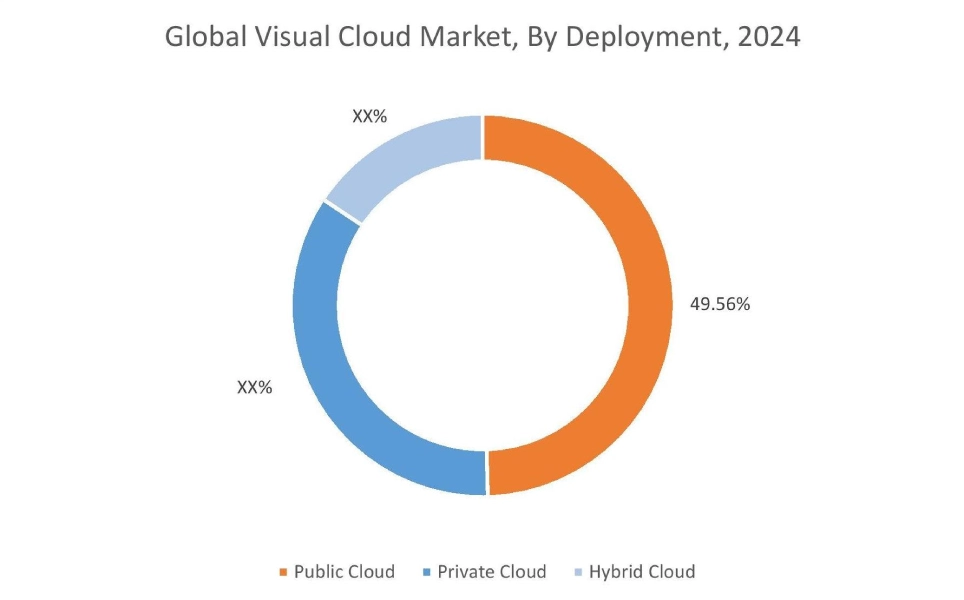
By End User:
Based on the end user, the market is segmented into media & entertainment, BFSI, IT & telecom, healthcare, retail & e-commerce, government & public sector, education, and others.
Trends in the End User:
- Visual cloud enables customers to virtually try on clothes, makeup, and accessories using augmented reality, reducing returns and enhancing the online shopping experience which in turn drives the visual cloud market.
- Law enforcement agencies are using cloud platforms to analyze video feeds for facial recognition, license plate recognition, and real-time threat detection which in turn drives the market.
Media & entertainment accounted for the largest revenue share in the year 2024.
- Increasing use of Generative AIis revolutionizing content creation, from scriptwriting and visualization to automated localization and dubbing, in turn driving the market.
- Further, growing use of cloud-based AI to analyze audience data in real-time for personalized content recommendations and targeted advertising, drives the market.
- Furthermore, there is an increasing focus on delivering low-latency content like live sports streaming and cloud gaming by processing data closer to the end user.
- For instance, in April 2024, Akamai Technologies introduced a new cloud service specifically for the media and entertainment industry. This offering is powered by NVIDIA RTX 4000 Ada Generation GPUs and is designed to help companies process video content more quickly and efficiently.
- Thus, as per visual cloud market analysis, Generative AI,advanced media analytics, and edge computing are driving the market.
Education is anticipated to register the fastest CAGR during the forecast period.
- Rising use of cloud-based data analytics and AI to create adaptive learning platforms in turn drives the market.
- Further, the solution allows researchers and students to collaborate on data-intensive visual projects, such as scientific visualizations and 3D modeling, from anywhere in the world which propels the market.
- Increasing adoption of technologies in education and research is expected to drive the market during the forecast period.
- Therefore, based on analysis, aforementioned factors are driving the market during the forecast period.
Regional Analysis:
The regions covered are North America, Europe, Asia Pacific, Middle East and Africa, and Latin America.
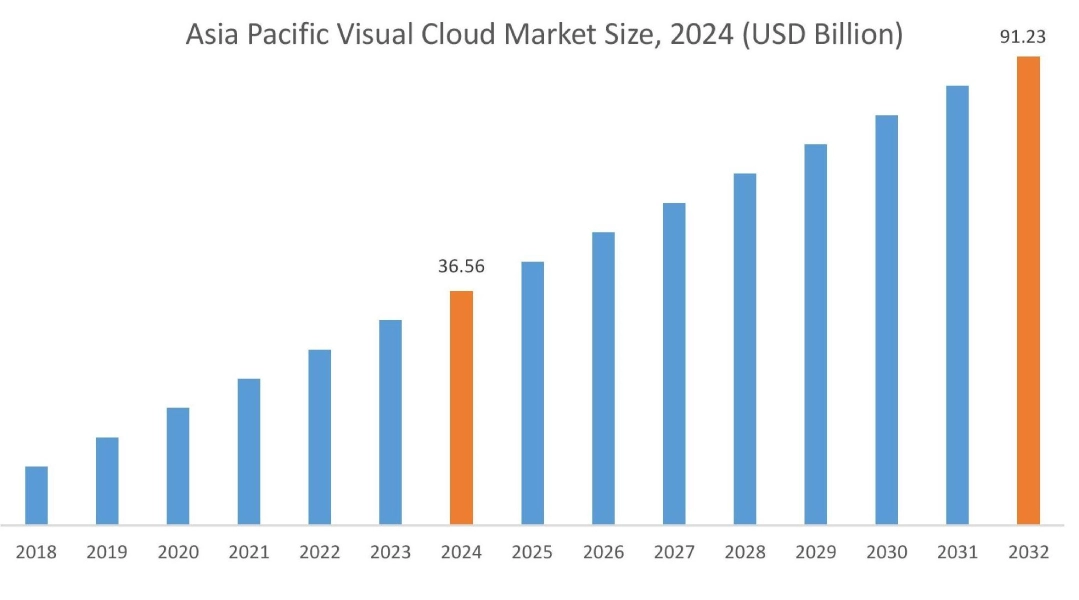
Asia Pacific region was valued at USD 36.56 Billion in 2024. Moreover, it is projected to grow by USD 40.52 Billion in 2025 and reach over USD 91.23 Billion by 2032. Out of this, China accounted for the maximum revenue share of 32.50%. The market for Visual Cloud is mainly driven by rapid digital transformation across the region, especially in countries like China and India, and the widespread adoption of 5G networks and mobile internet. Additionally, soaring demand for high-quality video content is further driving the market.
- For instance, according to International Trade Administration, between 2023 and 2027, India is expected to lead the world in retail e-commerce growth among 20 major countries, with a projected Compound Annual Growth Rate (CAGR) of 14.1%.
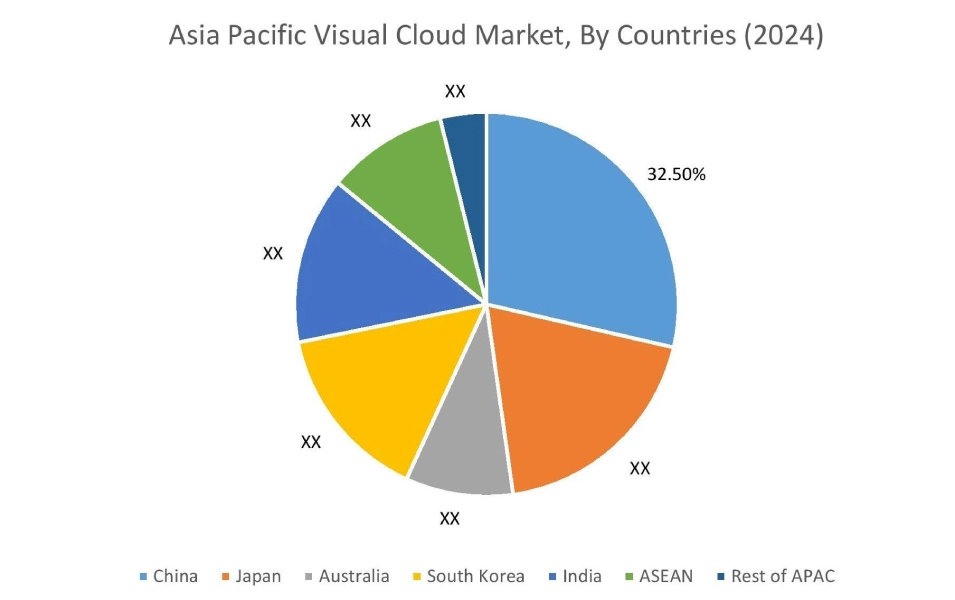
North America is estimated to reach over USD 105.73 Billion by 2032 from a value of USD 43.35 Billion in 2024 and is projected to grow by USD 47.95 Billion in 2025. The North American market is primarily driven by advanced technological infrastructure and strong consumer demand for immersive digital experiences.
- In April 2024, Cloud Software Group Inc. and Microsoft Corp. entered into an eight-year strategic partnership to enhance their collaboration. The agreement focuses on two key areas: improving the go-to-market strategy for Citrix virtual application and desktop platforms and developing new cloud and AI solutions with an integrated product roadmap.
The regional analysis depicts that strong regulatory framework and a mature digital infrastructure in Europe is driving the market. Additionally, factors driving the market in the Middle East and African region are rapid rollout of 5G networks and growing e-commerce sector. Further, digital transformation across key economies like Brazil and Argentina, and increasing adoption of cloud computing and AI technologies is paving the way for the progress of market trends in Latin America region.
Top Key Players & Market Share Insights:
The global visual cloud market is highly competitive with major players providing solutions to the national and international markets. Key players are adopting several strategies in research and development (R&D), product innovation, and end-user launches to hold a strong position in the visual cloud industry. Key players in the global visual cloud market include-
Recent Industry Developments :
Acquisition
In May 2024, Autodesk acquired Wonder Dynamics, a company that developed a cloud-based AI solution called Wonder Studio. This technology simplifies the process for artists to create and integrate 3D animated characters into live-action scenes, minimizing the need for complex, time-consuming steps.
Visual Cloud Market Report Insights :
| Report Attributes | Report Details |
| Study Timeline | 2019-2032 |
| Market Size in 2032 | USD 304.00 Billion |
| CAGR (2025-2032) | 13.2% |
| By Component |
|
| By Service Model |
|
| By Deployment |
|
| By End User |
|
| By Region |
|
| Key Players |
|
| North America | U.S. Canada Mexico |
| Europe | U.K. Germany France Spain Italy Russia Benelux Rest of Europe |
| APAC | China South Korea Japan India Australia ASEAN Rest of Asia-Pacific |
| Middle East and Africa | GCC Turkey South Africa Rest of MEA |
| LATAM | Brazil Argentina Chile Rest of LATAM |
| Report Coverage |
|
Key Questions Answered in the Report
How big is the visual cloud market? +
The visual cloud market is estimated to reach over USD 304.00 Billion by 2032 from a value of USD 125.35 Billion in 2024 and is projected to grow by USD 138.57 Billion in 2025, growing at a CAGR of 13.2% from 2025 to 2032.
What specific segmentation details are covered in the visual cloud report? +
The visual cloud report includes specific segmentation details for component, service model, deployment, end user, and regions.
Which is the fastest segment anticipated to impact the market growth? +
In the visual cloud market, Software-as-a-Service (SaaS) is the fastest-growing segment during the forecast period.
Who are the major players in the visual cloud market? +
The key participants in the visual cloud market are Huawei (China), Oracle (US), Amazon Web Services (US), Microsoft (US), IBM (US), Google (US), Tencent (China), Cisco Systems (US), VMware (US), Alibaba (China) and others.
What are the key trends in the visual cloud market? +
The visual cloud market is being shaped by several key trends including integration of AI and machine learning, adoption of edge computing, rising 5G market, and growing need for immersive experiences like AR, VR, and cloud gaming.
